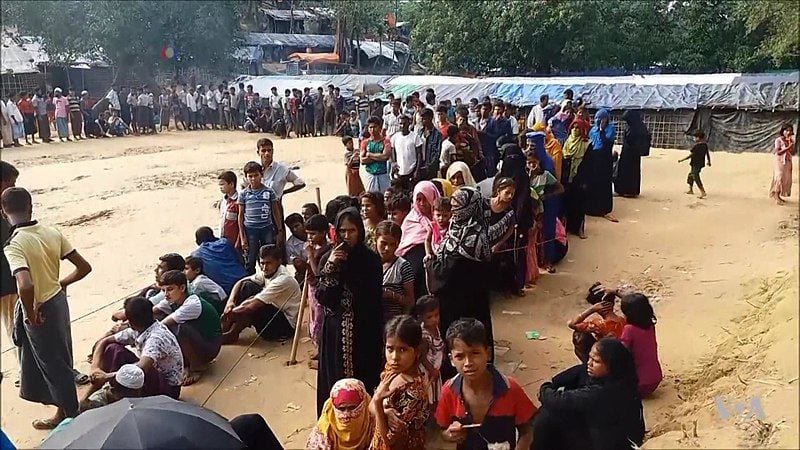By Abdullah Yusuf
It has been a year since the Rohingya crisis shocked the world, but what has changed? Abdullah Yusuf finds out.
This August marks a full year since one of the 21st century’s worst refugee crises gripped the world’s attention. In 2017, an unprecedented number of Rohingya Muslim refugees began fleeing Myanmar’s Rakhine state for neighbouring Bangladesh, after Myanmar’s military launched a crackdown in response to attacks on border posts by Rohingya rebels. This crisis is, as rightly pointed out by UN Secretary General Antonio Guterres, “a humanitarian and human rights nightmare”; the United Nations described the military offensive in Rakhine that provoked the exodus as a “textbook example of ethnic cleansing”.
A full year later, the plight of hundreds of thousands of Rohingya people is as abject as ever. In June 2018, Myanmar’s government signed an agreement with the United Nations that will lead to the “voluntary, safe, dignified, and sustainable” repatriation of some 700,000 Rohingya refugees back to their homes, or their place of choosing. At the same time, Myanmar’s civilian and military powers seem to have entirely ignored international condemnation of the crackdown and allegations that it amounted to ethnic cleansing, and Aung San Suu Kyi’s government is still insisting that only refugees with the correct identity documents can return.
Small wonder then that the Rohingya themselves remain pessimistic. A recent Amnesty International report on the crisis stated that former Rohingya villages – some of which had been burned to the ground – are now the site of new construction, including new roads and infrastructure for the military. Amnesty fears that the new construction makes it even less likely that the roughly 1m refugees who fled to Bangladesh will ever be able to return to their homes.
But even if the repatriation agreement is accepted at face value, without the oversight of the United Nations, Myanmar’s military cannot be trusted to broker the conflict-affected population’s competing demands fairly. It already stands accused of widespread violence against Rohingya Muslims within Rakhine state. The post-repatriation time will remain a period during which the big challenge will be about how to restore relationships across the divides in question.
And this challenge seems almost impossible. The agreement between the UN and the government of Myanmar is far from detailed, and violence against the Rohingya population is far from over, Rohingya refugees are hardly be keen to return home.
The reality is that without a deal on work rights, citizenship and so on, there are deep concerns that Rohingya refugees will be repatriated only to face a situation barely changed since they fled. In the meantime, the monsoon season has already started in Bangladesh, and there are grave concerns for the safety of the refugees. The situation is serious: caught between extreme weather, funding shortfalls and uncertainty about their future, the Rohingya refugees are still living in a humanitarian catastrophe.
Dereliction of duty
This disaster was created by the Myanmar government’s brutal policies. A recent report by the organisation Fortify Rights confirmed that Myanmar’s military systematically planned a genocidal campaign to rid the country of Rohingya Muslims. But the United Nations Security Council has avoided the “G” word since the exodus began in August 2017; to formally utter it would, in principle, have committed the council’s members to robust action that they are clearly unwilling to take.
As long as China and Russia are on Myanmar’s side, an intervention by the Security Council seems out of the question. Neighbouring India also shares no love for the Rohingya. Meanwhile, the rest of the world is still struggling to bring relief to the refugees. For the Rohingya refugees however, repatriation is not an option but an imperative, the only alternative to the limbo of protracted displacement.
The job of implementing the sustainable repatriation and reintegration of the Rohingya refugees obviously falls to Myanmar itself. So far, the government has done nothing to indicate that it will take that responsibility seriously – and beyond token humanitarian assistance, the countries of the global north have made no major commitment to resolve this crisis.
Somewhere along the line, it has been forgotten that Rakhine is one of Myanmar’s poorest and least developed states. According to World Bank estimates it suffers a poverty rate of 78%, dramatically higher than the national average of 37.5%. And since 2012, as communal violence between Buddhist and Muslim communities swept Rakhine, the authorities dramatically intensified their crackdown, deploying excessive lethal force, conducting mass arrests, and blocking aid to displaced Muslims.
The Rohingya are discriminated against in many ways, and are denied legal rights to challenge this discrimination. Their demand is not for an independent state per se, but rather for identity and recognition within the state. The Rohingya crisis is therefore not only a humanitarian emergency, but also concerns issues of security, identity and development. Unless these challenges are addressed, the long-term reconciliation processes in both communities will always be more conjecture than reality.
This article was originally published on The Conversation and has been republished under a creative commons license. For the original, click here.
Abdullah Yusuf is a Lecturer in Politics at the University of Dundee.
Disclaimer: The ideas expressed in this article reflect the author’s views and not necessarily the views of The Big Q.
You might also like:
Why do people remain in refugee camps indefinitely? 🔊

